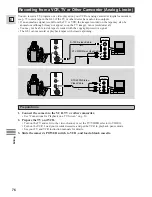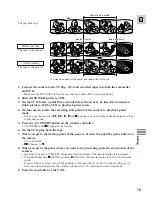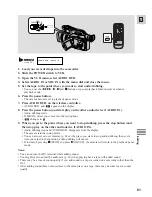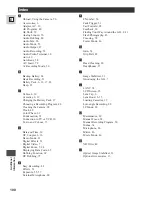
90
E
Ad
ditional
Inf
ormation
Power sources
• You can use the compact power adapter to operate your camera and charge battery packs in any country
where the electricity supply is between 100 and 240 V AC, 50–60 Hz. Contact your Canon dealer for
information about plug adapters for overseas use.
TV playback
• Although you can always play back your recordings in the viewfinder, your camera can only be
connected to TVs which use its NTSC system. This TV system is used in the following countries:
American Samoa, Bahama, Barbados, Bermuda, Bolivia, Canada, Chile, Colombia, Costa Rica, Cuba,
Ecuador, El Salvador, Guam, Guatemala, Greenland, Haiti, Honduras, Jamaica, Japan, Korea, Mexico,
Micronesia, Myanmar, Nicaragua, Panama, Peru, Philippines, Puerto Rico, Saint Lucia, Surinam,
Taiwan, Trinidad and Tobago, USA, Venezuela.
Maintenance
Using the camera abroad
LCD
• Clean the LCD screen using a commercially available glass cleaner.
• Where there is a big change in temperature, moisture may form on the surface of the screen. Wipe clean
with a soft, dry cloth.
• At low temperatures the display may appear to be much darker than usual. This is not a fault, and as the
screen warms up the display will return to normal.
Camera body and lens
• Use a soft, dry cloth to clean the camera body or lens. Never use chemically treated cloth or volatile
solvents such as paint thinner.
Video heads
• When mosaic-like noise appears on the playback picture, the video heads
may be dirty. When the video heads are badly contaminated, the camera may
show a blank blue screen.
• Clean the video heads using Canon’s DVM-CL Digital Video Head Cleaning
Cassette. If the “noise” remains, repeat the cleaning (up to maximum of five
times).
• Do not use a wet-type cleaning cassette, as this can cause damage.















































